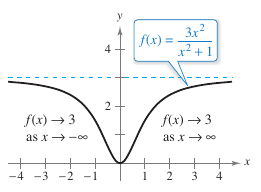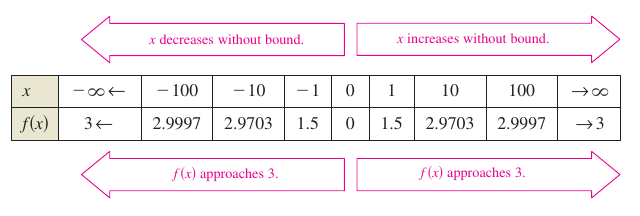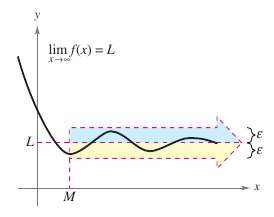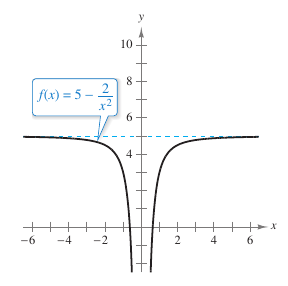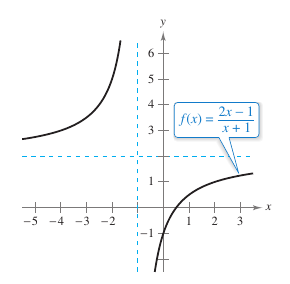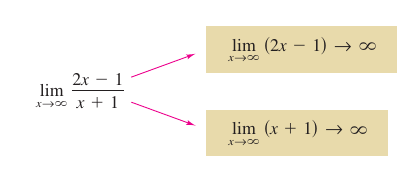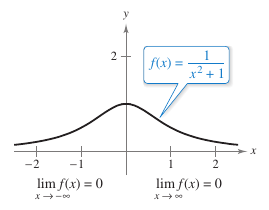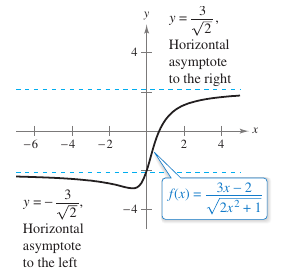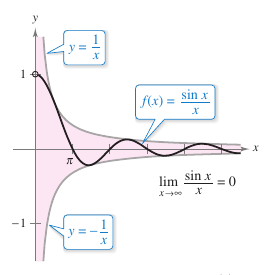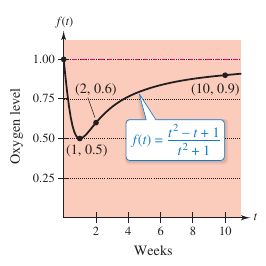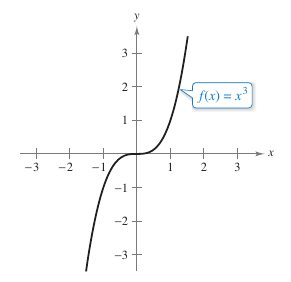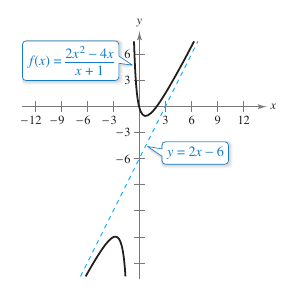Calculus I 03.05 Limits at Infinity
| Previous | Calculus I 03.04 Concavity and the Second Derivative Test |
| Next | Calculus I 03.06 Curve Sketching |
Contents
- 1 3.5 Limits at Infinity
- 1.1 Limits at Infinity
- 1.2 Horizontal Asymptotes
- 1.2.1 Definition 3.5.2 Horizontal Asymptotes
- 1.2.2 Theorem 3.5.1 Limits at Infinity
- 1.2.3 Example 3.5.1 Finding a Horizontal Limit at Infinity
- 1.2.4 Example 3.5.2 Finding a Horizontal and Vertical Limit at Infinity
- 1.2.5 Example 3.5.3 Comparing Three Rational Functions
- 1.2.6 Guidelines For Finding Limits \(\pm \infty\) For Rational Functions
- 1.2.7 Example 3.5.4 A Function with Two Horizontal Asymptotes
- 1.2.8 Example 3.5.5 Limits with Trigonometric Functions
- 1.2.9 Example 3.5.6 Oxygen Level in a Pond
- 1.3 Infinite Limits at Infinity
- 2 Internal Links
3.5 Limits at Infinity
- Determine finite limits at infinity.
- Determine the horizontal asymptotes, if any, for a function's graph.
- Determine infinite limits at infinity.
- Limits at Infinity
Limits at Infinity
|
|
Functions display "end behavior" on an infinite interval. Consider the graph for
as shown in Figure 3.5.1. As the graph for \(f(x)\) approaches 3 as \(x\)-values increase or decrease without bound. Table 3.5.1 displays the same conclusions numerically.
Table 3.5.1 suggests that the value for \(f(x)\) approaches 3 as \(x\) increases without bound \((x \to \infty)\). Conversely, \(f(x)\) approaches 3 as \(x\) decreases without bound \((x \to -\infty)\). Limits at infinity are denoted by
The statement \(\lim_{x \to - \infty} f(x)=L\) or \(\lim_{x \to \infty} f(x)=L\) means the limit exists and the limit is equal to \(L\). To say that a statement is true as \(x\) increases without bound means that for some really large real number \(M\), the statement is true for all \(x\) in the interval \(\left \{x:\:x >M \right \} \). Definition 3.5.1 formally states this concept. |
Definition 3.5.1 Limits at Infinity
|
|
Let \(L\) be a real number.
|
Horizontal Asymptotes
Figure 3.5.2 displays the graph for \(f\) as it approaches the line \(y=L\) as \(x\) increases without bound. The line \(y=L\) is called a horizontal asymptote for \(f\)'s graph.
Definition 3.5.2 Horizontal Asymptotes
The line \(y=L\) is a horizontal asymptote for \(f\)'s graph when
- \(\lim_{x \to -\infty} f(x)= L \text{ or } \lim_{x \to \infty} f(x)= L .\)
- \(\lim_{x \to -\infty} f(x)= L \text{ or } \lim_{x \to \infty} f(x)= L .\)
It follows that any function's graph can have at most two horizontal asymptotes, one to the left and one to the right.
Limits at Infinity share properties with limits as discussed in Section 1.3. For example, if \(\lim_{x \to \infty} f(x)\) and \(\lim_{x \to \infty} g(x)\) both exist, then
- $$\lim_{x \to \infty} \left [ f(x) + g(x) \right ] = \lim_{x \to \infty} f(x) + \lim_{x \to \infty}g(x)$$
and
- $$\lim_{x \to \infty} \left [ f(x)g(x) \right ] = \left [ \lim_{x \to \infty} f(x)\right] \left[\lim_{x \to \infty}g(x) \right ].$$
Similar properties hold for limits at \(-\infty\).
Theorem 3.5.1 Limits at Infinity
If \(r\) is a positive rational number and \(c\) is any real number, then
- $$\lim_{x \to \infty} \frac{c}{x^r}=0.$$
Furthermore, if \(x^r\) is defined when \(x<0\), then
- $$\lim_{x \to -\infty} \frac{c}{x^r}=0.$$
Example 3.5.1 Finding a Horizontal Limit at Infinity
|
|
Find the limit:
Solution Applying Theorem 3.4.4 produces
Therefore, the line \(y=5\) is a horizontal asymptote to the right. By finding the limit
yields that \(y=5\) is also a horizontal asymptote from the left, as shown in Figure 3.5.3. |
Example 3.5.2 Finding a Horizontal and Vertical Limit at Infinity
|
|
Find the limit:
Solution Note that the numerator and denominator approach infinity as \(x\) approaches infinity. This results in \(\frac{\infty}{\infty}\), an indeterminate form. To solve it divide the numerator and denominator by the highest power for \(x\) in the denominator.
Therefore, the line \(y=2\) is a horizontal asymptote to the right. By taking the limit as \(x \to -\infty\) produces a horizontal asymptote to the left, as shown in Figure 3.5.4. |
Example 3.5.3 Comparing Three Rational Functions
Find each limit.
- $$\textbf{a. }\:\lim_{x \to \infty} \frac{2x+5}{3x^2+1} \:\:\:\:\textbf{b. }\:\lim_{x \to \infty} \frac{2x^2+5}{3x^2+1}\textbf{c. }\:\lim_{x \to \infty} \frac{2x^3+5}{3x^2+1}$$
Solution Solving each case produces the indeterminate form \(\infty/\infty\).
a. Divide both numerator and denominator by \(x^2\).
- $$\lim_{x \to \infty} \frac{2x+5}{3x^2+1}=\lim_{x \to \infty} \frac{(2/x)+(5/x^2)}{3+(1/x^2)}=\frac{0+0}{3+0}=\frac{0}{3}=0$$
b. Divide both numerator and denominator by \(x^2\).
- $$\lim_{x \to \infty} \frac{2x^2+5}{3x^2+1}=\lim_{x \to \infty} \frac{2+(5/x^2)}{3+(1/x^2)}=\frac{2+0}{3+0}=\frac{2}{3}$$
c. Divide both numerator and denominator by \(x^2\).
- $$\lim_{x \to \infty} \frac{2x^3+5}{3x^2+1}=\lim_{x \to \infty} \frac{2x+(5/x^2)}{3+(1/x^2)}=\frac{\infty}{3}$$
Therefore, the limit does not exist because the numerator increases without bound while the denominator approaches 3.
Guidelines For Finding Limits \(\pm \infty\) For Rational Functions
1. If the numerator's degree is less than the denominator's degree, then the rational function's limit is 0.
2. If the numerator's degree is equal the denominator's degree, then the rational function's limit is the ratio with the leading coefficients.
3. If the numerator's degree is greater than the denominator's degree, then the rational function's limit does not exist.
|
|
The guidelines for finding limits at infinity for rational functions seem reasonable considering large values for \(x\), the highest-power term for the rational function is the most "influential" in determining the limit. For example,
is 0 because the denominator overpowers the numerator as \(x\) increases or decreases without bound, as shown in Figure 3.5.5. The function shown in Figure 3.5.5 is a special case for a curve studied by the Italian mathematician Maria Gaetana Agnesi[1]. The general form is
Through a mistranslation of the Italian word vertéré, the curve is known as the Witches of Agnesi. Agnesi's work with this curve first appeared in a comprehensive text on calculus published in 1748. |
Figure 3.5.5 shows the function
- $$f(x)=\frac{1}{x^2+1}$$
approaching the same horizontal asymptote to the right and left. This is always true for rational functions. Irrational functions may approach different horizontal asymptotes to the right and left. This is demonstrated in Example 3.5.4.
Example 3.5.4 A Function with Two Horizontal Asymptotes
|
|
Find each limit.
Solution
Taking the limit produces.
b. For \(x<0\) use \(x=\sqrt{x^2}\). Dividing the numerator and denominator by \(x\) produces.
Taking the limit produces.
Figure 3.5.6 displays the graph. |
The Squeeze Theorem can evaluate limits at infinity.
Example 3.5.5 Limits with Trigonometric Functions
|
|
Find each limit.
Solution
where
Applying the Squeeze Theorem produces
as shown in Figure 3.5.7. |
Example 3.5.6 Oxygen Level in a Pond
|
|
Let \(f(t)\) measure the oxygen level in a pond, where \(f(t)=1\) is the normal, unpolluted level and time \(t\) is measured in weeks. When \(t=0\), organic waste is dumped into the pond. As the waste material oxidizes, the oxygen level is expressed as
After 1 week what is the oxygen level as a percentage from normal? After 2 weeks? After 10 weeks? What is the limit as \(t\) approaches infinity?
Find the limit as \(t\) approaches infinity by applying the guidelines or divide the numerator and denominator by \(t^2\) to obtain
as shown in Figure 3.5.8. |
Infinite Limits at Infinity
Many functions do not approach a finite limit as \(x\) increases or decreases without bound. For example, no polynomial function has a finite limit at infinity. Definition 3.5.3 describes how polynomial and other functions behave at infinity.
Definition 3.5.3 Infinite Limits at Infinity
Let \(f\) be a differentiable function defined on the interval \((a,\infty)\).
1. The statement \(\lim_{x \to \infty}f(x)=\infty\) means that for each positive number \(M\), there is a corresponding number \(N>0\) such that \(f(x)>M\) whenever \(x>N\).
2. The statement \(\lim_{x \to \infty}f(x)=-\infty\) means that for each negative number \(M\), there is a corresponding number \(N>0\) such that \(f(x)<M\) whenever \(x>N\).
Definition 3.5.3 can be extended to these statements
- $$\lim_{x \to -\infty}f(x)=\infty \text{ and }\lim_{x \to -\infty}f(x)=-\infty.$$
Determining if a function has an infinite limit at infinity is useful in analyzing the “end behavior” for its graph. This is described in Section 3.6 Curve Sketching.
Example 3.5.7 Finding Infinite Limits at Infinity for Polynomial Functions
|
|
Find each limit.
Solution
b. As \(x\) decreases without bound, \(x^3\) also decreases without bound. It can be written as
Figure 3.5.9 shows the graph for \(f(x)=x^3\) these two results. |
Example 3.5.8 Finding Infinite Limits at Infinity for Fractional-Polynomial Functions
|
|
Find each limit.
Solution
b. As \(x\) decreases without bound, \(x^3\) also decreases without bound. It can be written as
As \(x\) approaches \(\pm \infty\), the function \( f(x)=(2x^2-4x)/(x+1) \) behaves like the function \(g(x)=2x-6\). Section 3.6 describes this as line \(y=2x-6\) is a slant asymptote to \(f\)'s graph, as shown in Figure 3.5.10. Figure 3.5.9 shows the graph for \(f(x)=x^3\) these two results. |
Internal Links
Parent Article: Calculus I 03 Differentiation Applications
